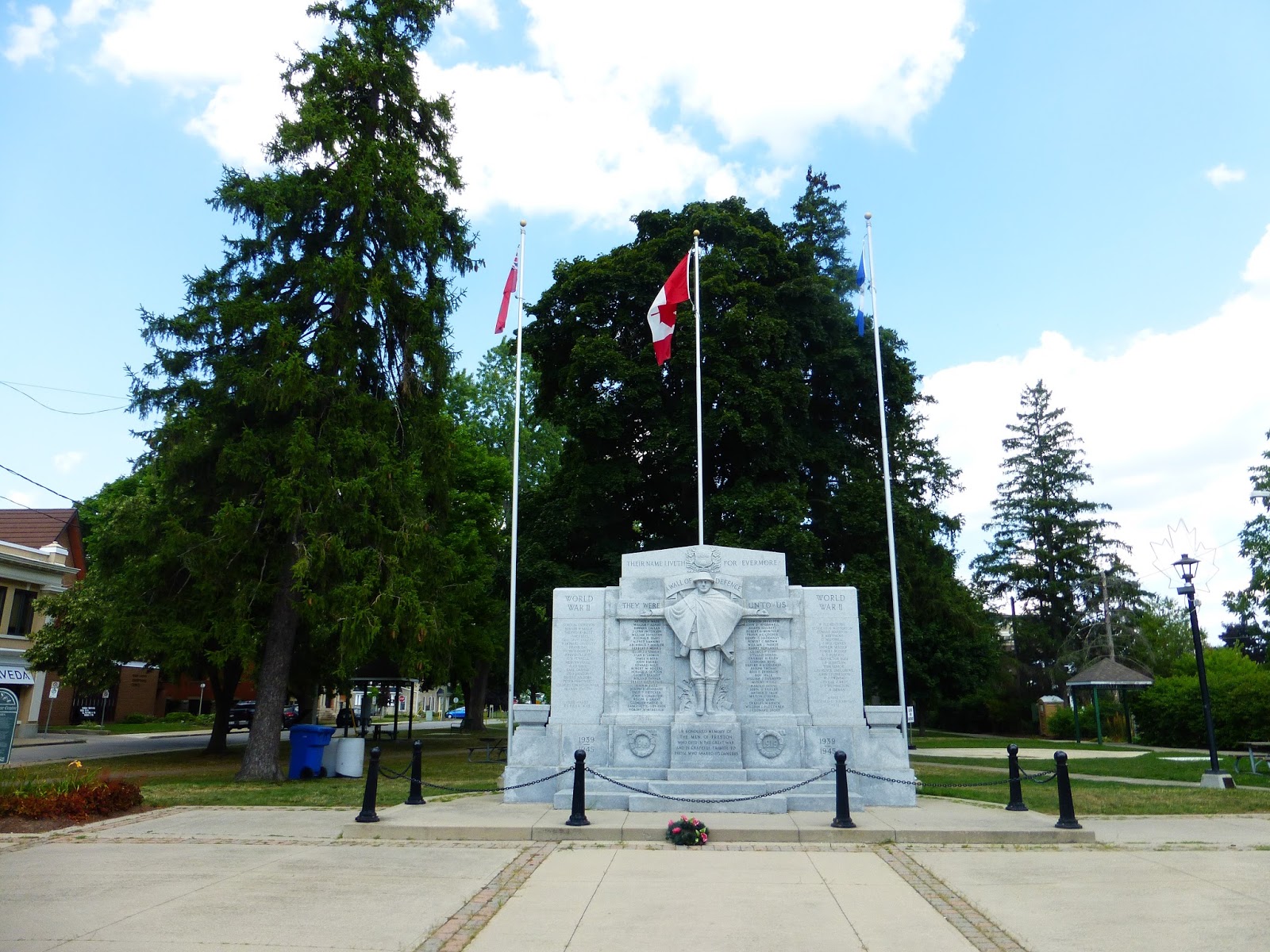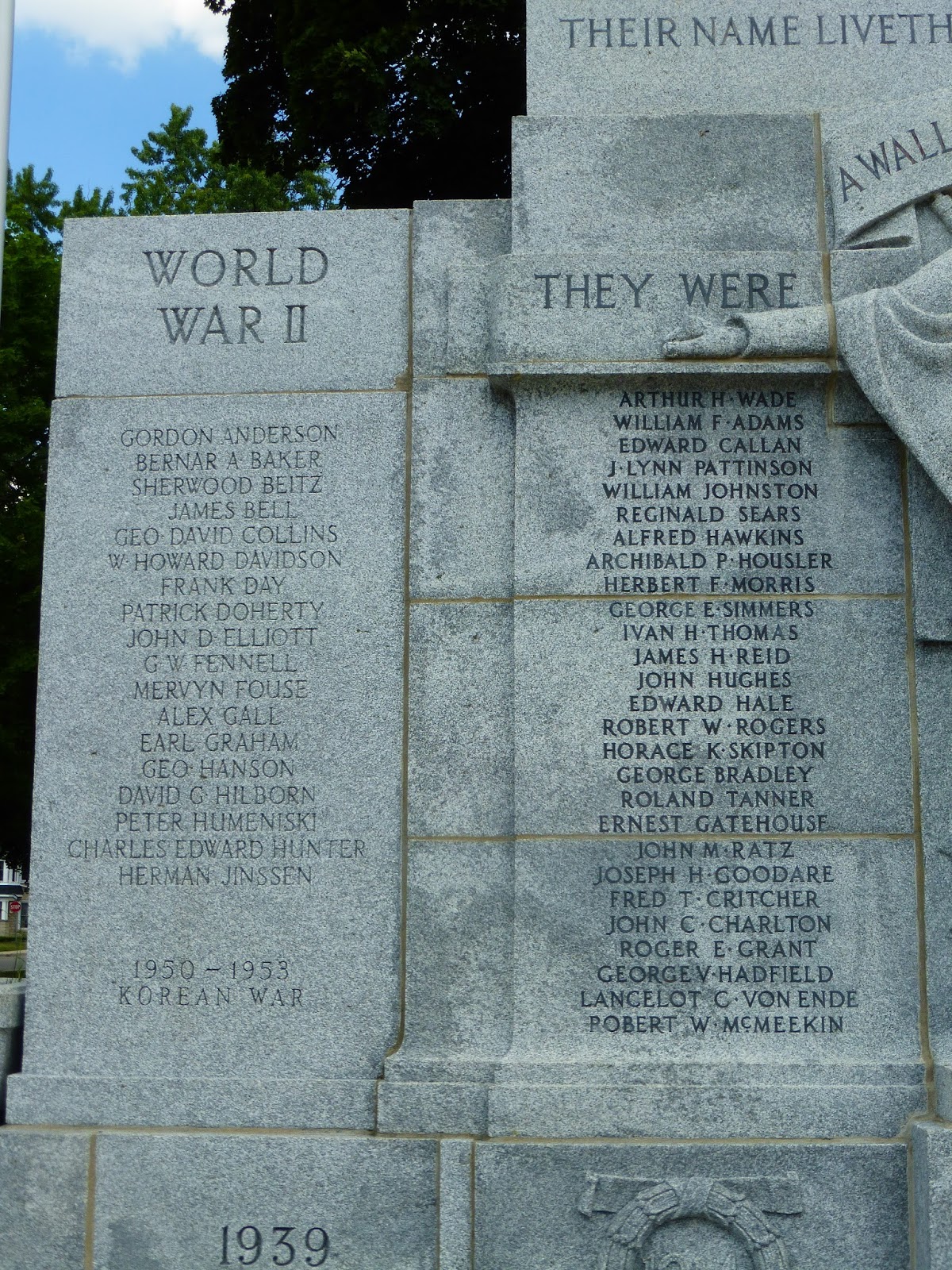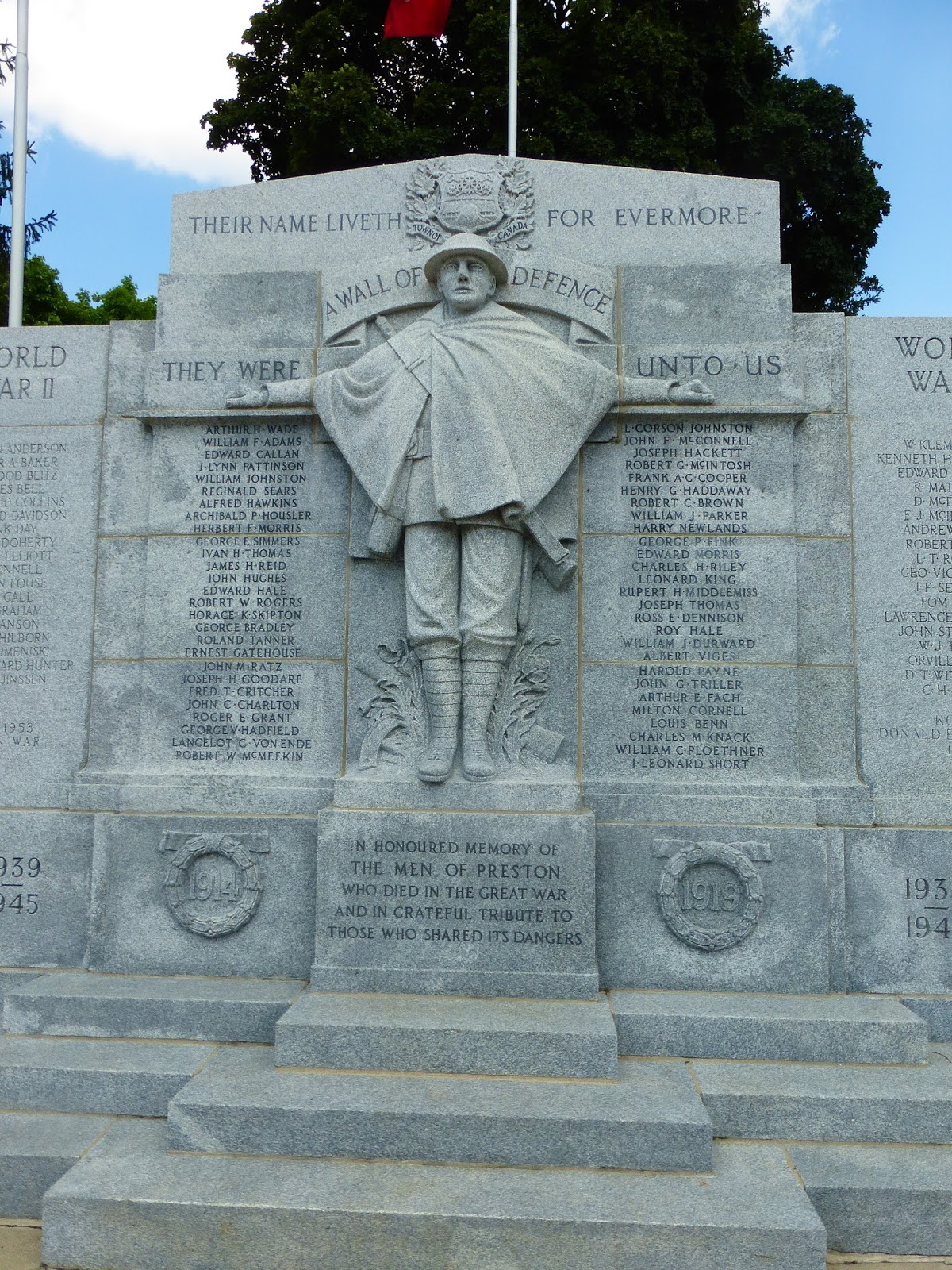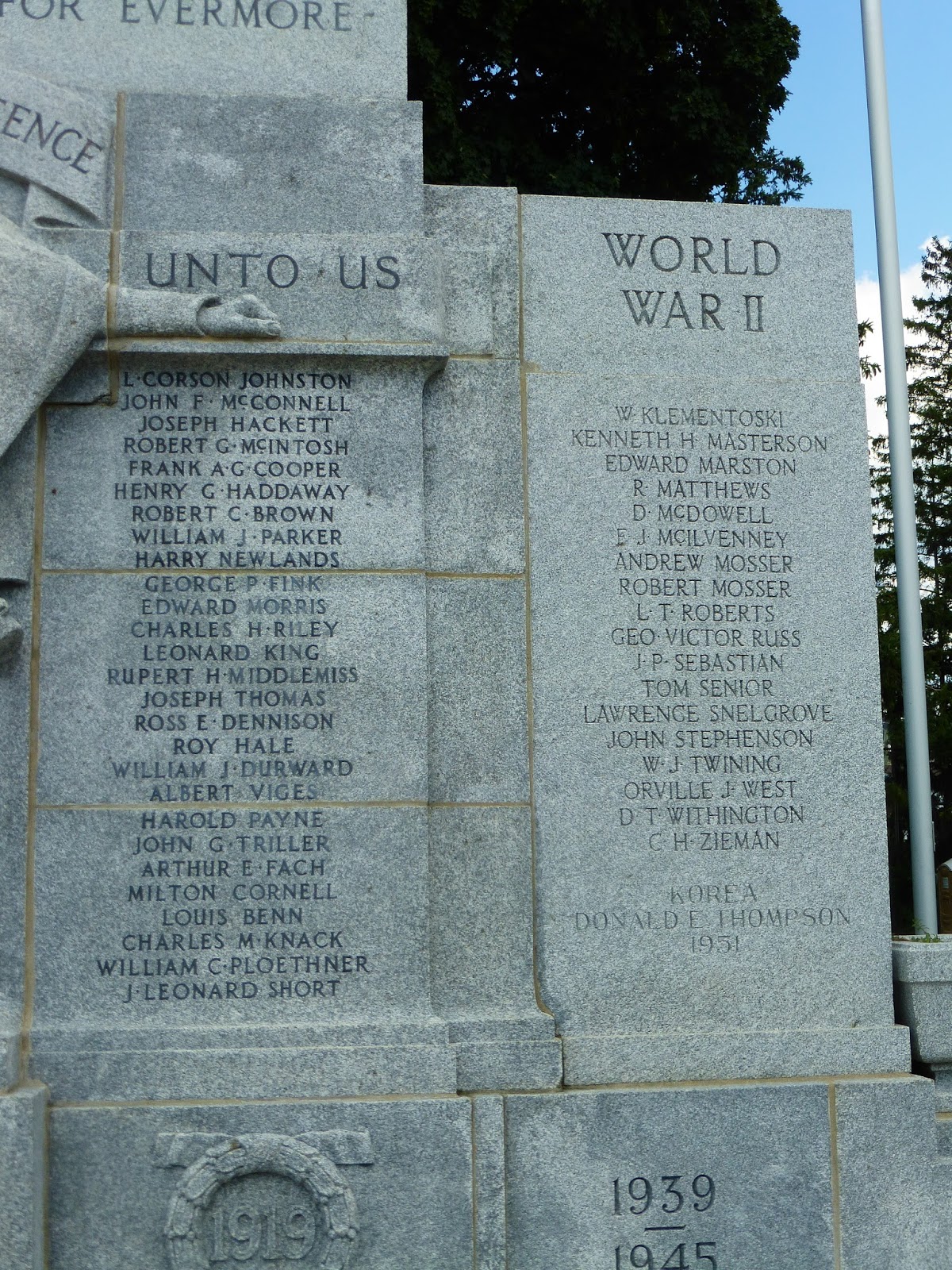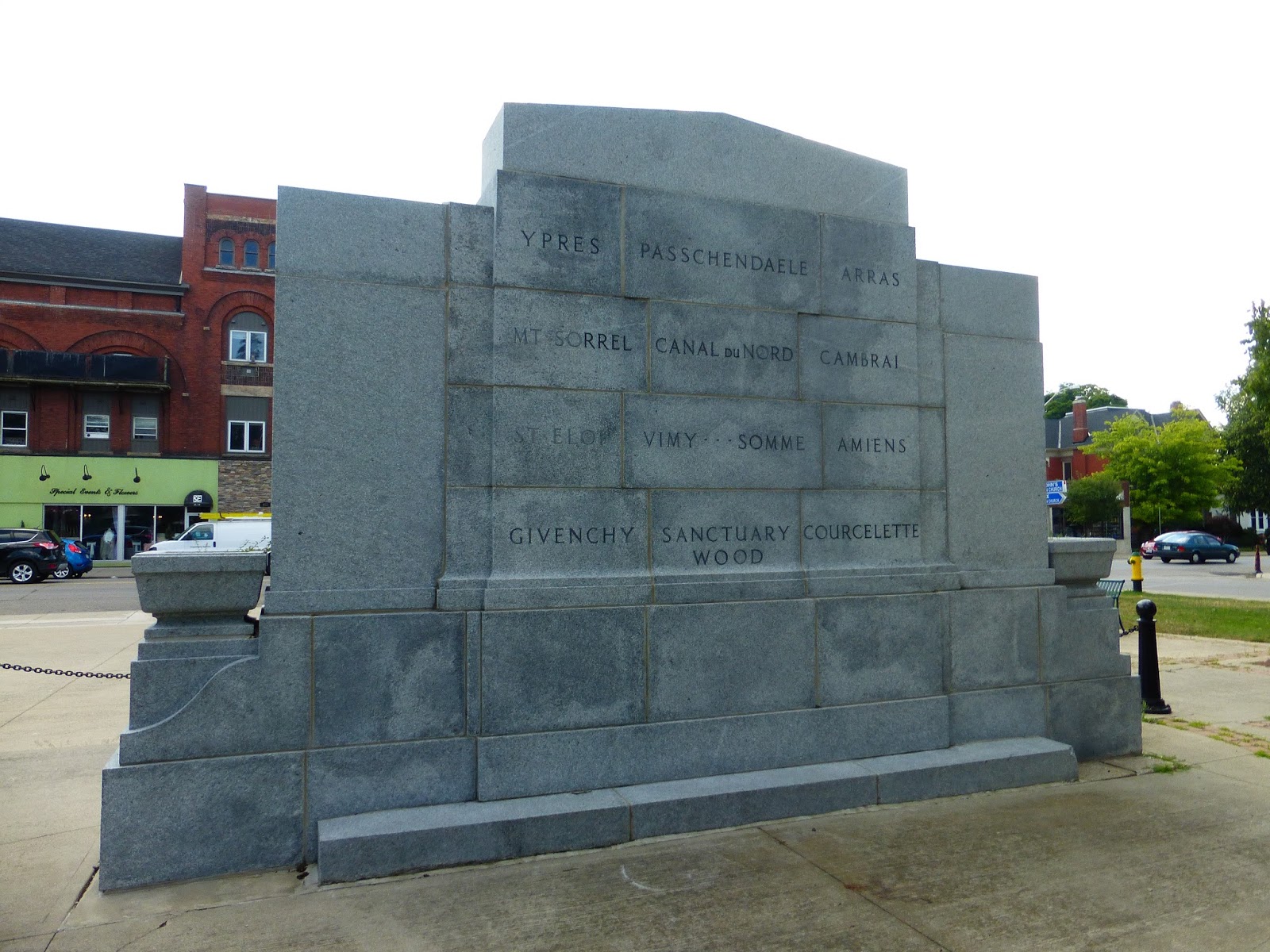Preston Cenotaph
Municipality/Province: Preston, ON
Memorial number: 35011-008
Type: Wall, statue
Address: 616 King Street E
Location: Central Park
GPS coordinates: Lat: 43.3964441 Long: -80.3594867
Photo credit: Tim Laye, Ontario War Memorials
This memorial was erected in 1926, in memory of the town's fallen soldiers. It was first unveiled on November 8, 1926, by the Lt. Governor of Ontario Col. Henry Cockshutt. The structure was erected by the McIntosh Granite Co. of Toronto and was built of Canadian grey granite, "all fine hammered finish".
At the centre of the monument is a seven-foot high soldier with arms outstretched, carved in high relief. The soldier emphasizes the whole meaning of the monument, which is carved on the band above the statue: "They were a wall of defence unto us". At the feet of the soldier is carved a broken gun carriage overgrown by poppies. The town crest of Preston is carved into the capstone along with the words "Their names liveth evermore" arranged on either side.
On each side of the statue are panels upon which are carved the names of the Preston men who died in the First and Second World Wars and the Korean War. The names of the First World War fallen are written in lead while those of the later wars are carved into the stone. The back of the memorial carries the names of some of the great battles of the first world war including Ypres, Somme, Mount Sorel, Vimy, Passchendale, Amiens, Arras, Cambrai, Givenchy, St. Eloi, Sanctuary Wood du Nord and Courcelette. The panel which holds the names of Preston's Second World War and Korean War dead were added early in 1949.
On November 11, 1918, the news of the final end of the "War To End All Wars" arrived in the Galt at 4:40 A.M. The breaking of dawn on that first Armistice Day was greeted with the continuous ringing of bells and factory whistles. The crowds gathered in the downtown area and were marching in impromptu parades, led by the boys banging on tin pots. The celebrations gained momentum and the parades took a more "official" look as they were joined by the Salvation Army and Galt Kiltie Bands.
Some young men, caught up in the celebratory mood and ignoring the possible hazardous consequences, ignited a bonfire fed by wagons from a nearby livery stable, at the intersection of Main and Water and proceeded to parade around the blaze. The schools and factories were closed as everyone joined in the festivities. It was a gigantic and magnificent parade. The parade was said to be two miles long and required 45 minutes to pass any given point. The celebrations continued into the evening, with people dressed in all sorts of weird costumes.
On the next day, Tuesday, November 12, a few factories reopened but had to close down again when only a few workers put in an appearance. The afternoon saw more parades and a football game in Dickson Park. By Wednesday, city and business leaders were feeling that the time had to come for the public celebrations to end and consequently that day the Galt Reporter carried two front page appeals. The first was signed by the Mayor and urged workers to return to the factories. It read in part: "We kept the home fires burning, now keep the home wheels turning. Now back to work and be a happy Galtonian". The second, smaller appeal carried the signature of the Chairman of the Public School Board and urged that children be sent back to school. There can be no doubt that the dominant feelings on that first Armistice Day were those of relief and thanks that the killing had finally stopped, combined with a liberal dose of the joy that can come only with final victory after a long and bitter struggle.
The cares of war could finally be set aside after four long years and, for this day at least, the sorrow felt for those lost in battle could be forgotten. There would be other days to remember the 348 soldiers from Galt, Preston and Hespeler who died in France. After the end of the First World War, these men were remembered on Armistice Day each year, as they were in 1920 when "Canada's ordinary activities, in practically all of the Dominion, were suspended for two minutes at noon in silent and honourable memoriam to the Canadian warriors and nurses who, by the sacrifice of their lives, helped to make possible the signing of the armistice".
There were other local services to mark the day but local war memorials were lacking until 1926 when Preston's Patriotic Society raised a Cenotaph at the front of Central Park on King Street. Source: Cambridge Reporter Jim Quantrell, City Archivist November 27, 1989 In 1991, the memorial was in need of repair. A Toronto restoration company estimated the work to cost approximately $7,750, unfortunately, the city's budget didn't permit this type of expenditure. An agreement between the Royal Canadian Legion Branch 126 and the city sited how the city would repay the Legion for half of the expense the following year. The project coordinator was to make sure the restoration didn't interfere with November 11th Remembrance Day services. Source: Cambridge Times Dave Menary October 6, 1991
Inscription found on memorial
[front/devant]
THEIR NAME LIVETH FOR EVERMORE
A WALL OF DEFENCE
THEY WERE UNTO US
- ARTHUR H. WADE
- WILLIAM F. ADAMS
- EDWARD CALLAN
- J. LYNN PATTINSON
- WILLIAM JOHNSTON
- REGINALD SEARS
- ALFRED HAWKINS
- ARCHIBALD P. HOUSLER
- HERBERT F. MORRIS
- GEORGE E. SIMMERS
- IVAN H. THOMAS
- JAMES H. REID
- JOHN HUGHES
- EDWARD HALE
- ROBERT W. ROGERS
- HORACE K. SKIPTON
- GEORGE BRADLEY
- ROLAND TANNER
- ERNEST GATEHOUSE
- JOHN M. RATZ
- JOSEPH H. GOODARE
- FRED T. CRITCHER
- JOHN C. CHARLTON
- ROGER E. GRANT
- GEORGE V. HADFIELD
- LANCELOT C. VON ENDE
- ROBERT W. McMEEKIN
- L. CORSON JOHNSTON
- JOHN F. McCONNELL
- JOSEPH HACKETT
- ROBERT G. McINTOSH
- FRANK A.G. COOPER
- HENRY G. HADDAWAY
- ROBERT C. BROWN
- WILLIAM J. PARKER
- HARRY NEWLANDS
- GEORGE P. FINK
- EDWARD MORRIS
- CHARLES H. RILEY
- LEONARD KING
- RUPERT H. MIDDLEMISS
- JOSEPH THOMAS
- ROSS E. DENNISON
- ROY HALE
- WILLIAM J. DURWARD
- ALBERT VIGES
- HAROLD PAYNE
- JOHN G. TRILLER
- ARTHUR E. FACH
- MILTON CORNELL
- LOUIS BENN
- CHARLES M. KNACK
- WILLIAM C. PLOETHNER
- J. LEONARD SHORT
IN HONOURED MEMORY OF
THE MEN OF PRESTON
WHO DIED IN THE GREAT WAR
AND IN GRATEFUL TRIBUTE TO
THOSE WHO SHARED ITS DANGERS
1914 1919
WORLD WAR II
GORDON ANDERSON
BERNAR A. BAKER
SHERWOOD BEITZ
JAMES BELL
GEO. DAVID COLLINS
W. HOWARD DAVIDSON
FRANK DAY
PATRICK DOHERTY
JOHN D. ELLIOTT
G.W. FENNELL
MERVYN FOUSE
ALEX GALL
EARL GRAHAM
GEO. HANSON
DAVID G. HILBORN
PETER HUMENISKI
CHARLES EDWARD HUNTER
HERMAN JINSSEN
1950-1953
KOREAN WAR
1939
1945
WORLD WAR II
W. KLEMENTOSKI
KENNETH H. MASTERTON
EDWARD MARSTON
R. MATTHEWS
D. McDOWELL
F.J. McILVENNEY
ANDREW MOSSER
ROBERT MOSSER
L.T. ROBERTS
GEO. VICTOR RUSS
J.P. SEBASTIAN
TOM SENIOR
LAWRENCE SNELGROVE
JOHN STEPHENSON
W.J. TWINING
ORVILLE J. WEST
D.T. WITHINGTON
C.H. ZIEMAN
KOREA
DONALD E. THOMPSON
1951
1939
1945
[back/arrière]
YPRES PASSCHENDAELE ARRAS
MT. SORREL CANAL DU NORD CAMBRAI
ST. ELOI VIMY SOMME AMIENS
GIVENCHY SANCTUARY WOOD COURCELETTE
Street view
Note
This information is provided by contributors and Veterans Affairs Canada makes it available as a service to the public. Veterans Affairs Canada is not responsible for the accuracy, currency or reliability of the information.
- Date modified:
